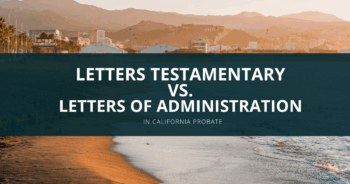Safeguarding an Heir with Addiction Challenges Through California Estate Planning
Crafting an inheritance plan for a loved one navigating substance use disorder requires a delicate balance of empathy and legal acumen. A thoughtfully designed California estate plan can secure assets, fund recovery efforts, and promote healing, all while preventing misuse and warding off creditor claims. This guide will illuminate:
- The distinct hurdles beneficiaries with addiction face when inheriting assets.
- How California’s spendthrift, discretionary, and incentive trusts operate to protect and support an heir battling addiction.
- The essential qualities to seek in a trustee who can effectively balance care with oversight.
- Key provisions within the California Probate Code, insights from relevant case law, and complementary tools like powers of attorney.
- Real-world scenarios that showcase best practices and offer cautionary lessons.
Our dedicated Estate Planning and Probate Law Firm, accessible at https://opelon.com, offers specialized expertise to construct these protective frameworks with both compassion and authority.
7 Real-World Examples and Case Studies of Addiction Trusts in California
Illustrative examples provide practical insights into how protective trusts function in real-world scenarios and offer valuable lessons for successful implementation.
1. Discretionary Trust for a Recovering Adult Child
Scenario: A San Diego family wanted to leave an inheritance to their adult son who had a history of opioid abuse.
Trust Strategy: They established a discretionary trust that gave the trustee full authority to decide if and when distributions were made.
Outcome: Instead of receiving a lump sum, the beneficiary’s housing and health insurance were paid directly by the trustee. This limited financial access reduced the risk of relapse while ensuring essential needs were covered.
Lesson: Granting trustees broad discretion can prevent misuse of funds while still providing meaningful support.
2. Incentive-Based Addiction Trust
Scenario: A parent in Orange County wanted to encourage their daughter, who struggled with alcohol dependency, to continue with treatment.
Trust Strategy: The trust included “incentive provisions,” where the daughter could receive limited cash distributions if she provided proof of regular attendance in a rehabilitation program.
Outcome: The structure motivated her to remain engaged in treatment, while still protecting the majority of her inheritance until long-term stability was demonstrated.
Lesson: Incentive clauses can align distributions with positive life choices, but must be drafted flexibly to account for relapse and recovery cycles.
3. Supplemental Needs Addiction Trust
Scenario: A family in Los Angeles worried that their son’s methamphetamine addiction could leave him homeless or without medical care.
Trust Strategy: A supplemental needs trust was created to cover non-cash benefits such as therapy, vocational training, and sober living housing, without providing unrestricted cash.
Outcome: The trustee paid for structured living arrangements directly, ensuring the son’s basic support while reducing the risk of funds being diverted to substance use.
Lesson: Restricting distributions to services rather than cash can safeguard a beneficiary’s well-being without fueling harmful behavior.
4. Addiction Trust Combined with a Professional Trustee
Scenario: In a Northern California case, parents wanted to leave assets for their daughter but knew family members could not manage the responsibility.
Trust Strategy: They appointed a professional fiduciary as trustee with authority to consult medical providers and require testing before making distributions.
Outcome: The professional trustee applied objective standards and maintained boundaries that family members might have struggled to enforce.
Lesson: Using an independent trustee may reduce family conflict and ensure trust terms are applied consistently.
5. Addiction Trust with Staggered Access
Scenario: A Bay Area physician with significant assets wanted to provide for his son who was in recovery but feared relapse.
Trust Strategy: The trust allowed for gradual distributions at ages 30, 35, and 40, but only if the trustee determined the beneficiary was sober and financially stable.
Outcome: The staggered structure reduced the risk of a large inheritance being wasted during relapse periods.
Lesson: Delaying or staggering distributions can protect wealth while giving beneficiaries time to mature and stabilize.
6. Addiction Trust Integrated with Divorce Protection
Scenario: A Ventura County family worried their daughter’s spouse could access funds during her recovery struggles.
Trust Strategy: The trust included strong spendthrift provisions and explicitly maintained the inheritance as separate property.
Outcome: Even during divorce proceedings, the daughter’s inheritance remained shielded from claims by her spouse.
Lesson: Addiction trusts may also protect assets from outside influences, such as creditors or divorcing spouses.
7. Emergency Distribution Controls
Scenario: A family in Sacramento wanted flexibility to address relapse situations.
Trust Strategy: The trust permitted emergency distributions only for medical or treatment purposes, with verification from licensed providers.
Outcome: When the beneficiary relapsed, the trustee was able to quickly approve payments for detox and rehabilitation services without giving direct access to funds.
Lesson: Emergency provisions may allow for rapid intervention while still protecting the inheritance.
Key Takeaways
Addiction trusts in California are highly customizable.
Success often depends on careful drafting, clear trustee guidance, and coordination with medical professionals.
Trusts generally work best when structured to provide support without enabling harmful behavior.
How Do These Case Studies Inform Best Practices for California Estate Planning?
These examples powerfully underscore that the most effective approach involves combining robust spendthrift protection with carefully crafted incentive provisions and the appointment of a qualified trustee. This integrated strategy achieves both fiduciary security and therapeutic encouragement—essential elements for a trust that genuinely serves the long-term well-being of an heir facing addiction.
Navigating the Challenges of Inheritance for Beneficiaries with Addiction in California
Beneficiaries grappling with substance use disorder often find themselves lacking the financial stability and decision-making clarity necessary to manage an inheritance responsibly. This vulnerability can unfortunately, lead to squandered resources, enabling behaviors, and increased exposure to creditors.
Estate Planning Strategies for Beneficiaries Facing Substance Abuse Issues
When planning an inheritance for a loved one contending with substance use disorder, trusts can be meticulously structured to offer support without inadvertently fueling the addiction. Spendthrift trusts serve to shield assets from creditors and impulsive spending, while incentive trusts tie distributions to tangible sobriety milestones, such as completing rehabilitation programs or passing drug screenings.
The selection of an impartial, seasoned trustee is paramount for effective administration and the diligent enforcement of the trust’s conditions.
How Does Addiction Impact a Beneficiary’s Financial Stability and Increase Inheritance Risks?
Addiction profoundly disrupts an individual’s ability to budget and control impulses, significantly elevating the risk that an heir might deplete inherited assets through treatment lapses or harmful behaviors.
For instance, immediate access to principal funds can trigger relapse-driven expenditures, jeopardizing long-term recovery and leaving the estate vulnerable to creditors or opportunistic individuals.
What Are the Common Pitfalls of Enabling Addiction Through Inheritance?
Families may unintentionally enable addiction when inheritance distributions are made without appropriate safeguards. Three primary risks emerge:
- The potential loss of crucial treatment funding due to unplanned withdrawals.
- The exacerbation of dependency occurs when readily available cash flow is diverted to substance purchases.
- The depletion of the estate can undermine the intended protection for other heirs.
These financial hazards starkly illustrate why unrestricted inheritances can exacerbate, rather than alleviate, the struggles associated with substance use disorders.
Why is Tailored Estate Planning Crucial for Beneficiaries with Addiction?
Custom-designed legal instruments, such as spendthrift and incentive trusts, align asset protection objectives with recovery goals. Rather than simply transferring unrestricted funds, these tools empower trustees to oversee disbursements, allocate resources for treatment, and enforce protocols for relapse, thereby ensuring the inheritance actively promotes healing rather than contributing to harm.
Understanding California Spendthrift Trusts and Their Role in Protecting an Addicted Beneficiary’s Inheritance
A California spendthrift trust is a sophisticated legal mechanism designed to restrict a beneficiary’s direct access to trust assets, thereby safeguarding these funds from the beneficiary’s potentially imprudent spending habits and claims by creditors.
What Legal Protections Does a Spendthrift Trust Offer Under the California Probate Code?
As outlined in California Probate Code Sections 15300–15307, a properly established spendthrift clause effectively prevents beneficiaries and most creditors from compelling the distribution of trust principal or income. By vesting the sole authority for distributions with the trustee, these trusts ensure that capital remains intact for essential needs such as treatment, housing, or education.
California Spendthrift Trust Law and Protections Against Creditors
California Probate Code Sections 15300-15307 govern the framework for spendthrift trusts, generally offering robust protection for trust principal and income against claims from beneficiaries’ creditors and from voluntary transfers by the beneficiary. However, these protections are not absolute, with notable exceptions for certain types of claims, including alimony, child support, and governmental claims. Furthermore, under Probate Code Section 15306.5, judgment creditors may be entitled to access up to 25% of the principal that would otherwise be distributed to the beneficiary.
This research confirms the specific California Probate Code sections cited in the article pertaining to spendthrift trusts, detailing their legal protections, as well as the limitations and exceptions concerning creditor claims, including the 25% rule and the enforceability of support orders.
What Are the Limitations and Exceptions to Spendthrift Trusts in California?
It is important to recognize that not all claims are barred by a spendthrift clause. Key exceptions include:
- Alimony and child support judgments, which remain enforceable notwithstanding a spendthrift clause.
- Government claims for the repayment of public assistance.
- Self-settled trusts, where an individual attempts to shield assets from which they themselves benefit, are generally deemed invalid under Section 15304.
These specific carve-outs necessitate meticulous trust design and expert legal counsel.
How Does a Spendthrift Trust Prevent Irresponsible Spending by Beneficiaries with Addiction?
By withholding direct ownership and control, the trust empowers a neutral trustee to:
- Authorize fund disbursements solely for approved purposes, such as treatment, rent, or essential living expenses.
- Postpone or suspend distributions if indicators of relapse emerge.
- Manage and invest the principal to foster long-term financial growth.
This structured oversight ensures that the inheritance serves the beneficiary’s recovery journey rather than fueling further addiction.
How Discretionary and Incentive Trusts Support Addiction Recovery in California Estate Planning
Beyond the protective shield of spendthrift provisions, discretionary and incentive trusts incorporate behavioral conditions and trustee discretion to actively promote sober living and adherence to treatment protocols.
What Authority Does a Trustee Possess in a Discretionary Trust for an Addicted Beneficiary?
Within a discretionary trust, the trustee holds comprehensive authority to determine the timing and amount of all distributions. This significant power enables the trustee to:
- Allocate funds strategically for therapy, housing, or vocational training.
- Withhold distributions if critical sobriety milestones are not achieved.
- Adjust the level of support based on the beneficiary’s evolving recovery needs.
Granting this level of discretion ensures that care is responsive and adaptive throughout each phase of addiction treatment.
How Are Incentive Trusts Structured to Motivate Sobriety and Treatment Milestones?
Incentive trusts are specifically designed to link financial disbursements to the achievement of clearly defined recovery goals. Common conditions include:
- Verified negative drug tests, substantiated by reports from licensed clinical facilities.
- Successful completion of a recognized rehabilitation program or a consistent course of counseling sessions.
- Demonstrated sustained employment or enrollment in an educational program.
Each successfully met milestone unlocks a predetermined payment, serving as a powerful motivator for continued progress in recovery.
Can Trusts Mandate Drug Testing and Other Conditions for Distributions in California?
Absolutely. California law permits the establishment of conditional distributions that are contingent upon verifiable drug testing or other certifications of sobriety. A trustee can legally require periodic submission of negative test results or proof of attendance at support group meetings. These requirements ensure that the inheritance directly supports and reinforces verifiable progress in recovery.
Drafting Trusts for Beneficiaries Facing Addiction Challenges
A meticulously drafted trust for a beneficiary struggling with addiction can provide essential treatment and ongoing support while simultaneously preventing the dissipation of valuable financial resources. Such trusts frequently grant the trustee sole discretion over all distributions, empowering them to fund therapy, secure housing, or support job training, and crucially, to deny funds if sobriety milestones are not met. The trust document can also explicitly authorize drug testing and require the beneficiary’s consent for the disclosure of results to the trustee, thereby ensuring compliance with recovery-focused conditions.
Selecting the Ideal Trustee for an Addiction Trust in California
The choice of trustee is absolutely critical—this individual or institution is responsible for upholding the trust’s protective provisions and actively supporting the beneficiary’s journey toward recovery.
What Qualifications and Responsibilities Should a Trustee Possess for Addiction Trusts?
An effective trustee appointed to manage an addiction trust should demonstrate:
- Fiduciary expertise in the prudent management of trust assets and investments.
- A solid understanding of addiction treatment protocols and the dynamics of recovery.
- Impartiality, enabling them to balance the beneficiary’s immediate needs with the overarching purpose of the trust.
Key responsibilities encompass the administration of distributions, diligent monitoring of evidence of sobriety, and effective communication with treatment providers.
What Are the Advantages and Disadvantages of Professional vs. Family Trustees in Addiction Estate Planning?
Trustee Type | Expertise | Neutrality | Cost | Communication Style |
|---|---|---|---|---|
Family Member | Intimate personal insight | Potential for bias | Minimal to none | Highly empathetic |
Professional Fiduciary | Specialized financial acumen | Objective oversight | Fees are applicable | Structured and professional |
How Should Trustees Engage in Communication with Beneficiaries and Treatment Providers?
Trustees should establish a cadence of regular check-ins with the beneficiary and secure written progress reports from counselors or physicians. Open, well-documented communication channels are essential for trustees to verify compliance with trust conditions and to adapt support plans effectively as the beneficiary’s recovery evolves.
Key California Probate Code Sections Governing Addiction Trusts and Beneficiary Protections
California’s Probate Code lays out the foundational rules for spendthrift, discretionary, and incentive trusts, while also clarifying creditor exceptions that are particularly relevant when dealing with beneficiaries facing addiction.
Which Probate Code Sections Define the Rules for Spendthrift and Discretionary Trusts?
| Code Section | Subject Matter | Impact |
|---|---|---|
| §15300–15304 | Spendthrift Clauses | Establishes the validity and enforceability of spendthrift clauses; prevents both voluntary and involuntary transfers of a beneficiary’s interest. Clarifies that self-settled trusts (where the settlor is also the beneficiary) are generally not protected. |
| §15306.5 | Creditor Access (25% Rule) | Allows judgment creditors to petition the court to reach up to 25% of distributions that would otherwise be made to the beneficiary, subject to the beneficiary’s support needs. |
| §15307 | Excess Distributions | Provides that any trust distributions not required for the beneficiary’s support may be reached by creditors, despite a spendthrift clause. |
How Do California Court Decisions Influence the Enforcement of Trusts for Beneficiaries with Addiction?
In significant legal precedents, such as the case of Frealy v. Reynolds, courts have affirmed trustees’ discretion to withhold funds following documented instances of relapse, reinforcing the enforceability of incentive-based conditions. These judicial decisions confirm that meticulously drafted addiction trusts are robust and capable of withstanding legal challenges.
How Does the Probate Code Address Creditor Claims Against Addiction Trusts?
While the majority of creditor actions are precluded under Section 15307, specific exceptions exist, notably for judgments related to public assistance and family support obligations. A thorough understanding of these exceptions enables estate planners to structure complementary agreements or supplemental funding mechanisms that safeguard essential treatment budgets.
Comprehensive Estate Planning Tools That Complement Addiction Trusts in California
A truly holistic estate plan integrates addiction trusts with other vital instruments designed to address potential incapacity, healthcare directives, family communication dynamics, and eligibility for government benefits.
How Do Powers of Attorney and Advanced Healthcare Directives Support Beneficiaries with Addiction?
Durable powers of attorney empower a designated agent to make critical financial or medical decisions should the beneficiary become incapacitated during their treatment journey. Advanced healthcare directives allow a trusted individual to authorize or refuse specific medical interventions, thereby ensuring continuity of care.
What Family Communication Strategies Facilitate the Implementation of Addiction-Focused Estate Plans?
Conducting transparent and empathetic family meetings, ideally guided by legal counsel or a neutral facilitator, is instrumental in setting clear expectations and minimizing potential conflicts. Providing a written “Letter of Intent” can further clarify the trust’s recovery-oriented objectives and offer guidance to loved ones on how best to support the beneficiary.
How Can Estate Planning Address Government Benefits and Financial Support for Heirs with Addiction?
Special needs planning strategies, including the establishment of supplemental needs trusts, can preserve eligibility for essential government programs like SSI or Medi-Cal while still allowing for discretionary funds to cover treatment expenses or living costs. Careful coordination of trust distributions with relevant benefit regulations is crucial to prevent unintended disqualification.
How Have Spendthrift and Incentive Trusts Successfully Protected Beneficiaries Dealing with Addiction?
In one anonymized case, a family established a spendthrift trust that provided regular living stipends and covered all necessary treatment costs. Over a five-year period, the beneficiary successfully maintained sobriety milestones, which were directly linked to incentive-based distributions, demonstrating significant improvement in stability and financial responsibility.
What Lessons Can Be Gleaned from Cautionary Cases Involving Addiction and Estate Planning?
A cautionary tale involved an inheritance provided without adequate structure, which unfortunately enabled relapse and led to the rapid depletion of assets. The absence of conditional trust provisions meant there was no mechanism for intervention, starkly highlighting the critical need for built-in recovery requirements and trustee discretion.
Establish a trust that includes a spendthrift clause and grants the trustee discretionary authority over distributions. Incorporate specific conditions—such as successful drug testing or completion of treatment programs—that must be met before funds are released, and clearly define permissible uses within the trust instrument.
Yes. Incentive or discretionary trusts can legally empower trustees to withhold distributions unless a beneficiary provides verifiable proof of negative drug screens obtained from a licensed facility, thereby directly linking financial support to demonstrated sobriety.
Spendthrift trusts do not offer protection against court-ordered support judgments (such as alimony or child support) or claims for government benefit recoupment. Furthermore, they cannot shield assets within self-settled trusts, meaning trusts created by the beneficiary for their own benefit.
Engage with an experienced estate planning attorney to draft a trust that incorporates both spendthrift and incentive provisions. This process involves appointing a suitable trustee and meticulously aligning distribution criteria with established clinical milestones. Our specialized team at https://opelon.com excels in creating these customized solutions.
An Addiction Trust is a specialized form of trust designed to support a loved one struggling with substance abuse. It generally includes trustee discretion, spendthrift provisions, and sometimes incentive clauses tied to treatment milestones. The goal is to provide care and stability while limiting financial harm.
Yes. California trusts may include “incentive provisions” that condition distributions on proof of sobriety, regular testing, or participation in treatment programs. These provisions should be drafted carefully to avoid being overly rigid, since recovery often involves relapse and ongoing support.
Spendthrift provisions restrict a beneficiary’s ability to assign, pledge, or spend future trust distributions. In California, this can help protect trust assets from both creditors and the beneficiary’s own impulsive financial decisions. Importantly, once funds are distributed, creditors and the beneficiary may still access them.
Families often appoint a neutral third party, such as a professional fiduciary or corporate trustee, to reduce conflict and enforce rules consistently. Trustees may be given authority to consult with doctors or treatment providers before approving distributions.
Yes. One effective approach is for the trustee to make payments directly to service providers, such as rehabilitation centers, landlords, or medical providers. This ensures the funds are used for their intended purpose rather than handed over in cash.
Direct inheritances may affect eligibility for programs such as SSI or Medi-Cal. However, a properly drafted discretionary or supplemental needs trust can typically preserve eligibility while still providing supplemental support.
Parents in California may choose to disinherit a child, but doing so often increases the risk of legal disputes. A carefully drafted trust that acknowledges the child and includes a no-contest clause may reduce the likelihood of a successful challenge.
In California, discretionary trusts give the trustee flexibility to respond to relapse situations. For example, the trustee may suspend cash distributions and instead authorize payments for treatment, sober living housing, or other structured support.
Through the careful structuring of trusts, leveraging clear legal authority under the California Probate Code, and fostering proactive family collaboration, estate plans can effectively protect assets while simultaneously nurturing the recovery journey of a beneficiary facing addiction.
Partnering with knowledgeable legal counsel at Opelon LLP ensures that each trust seamlessly integrates protective measures, behavioral incentives, and supportive mechanisms—ultimately guiding an heir toward lasting stability and enhanced well-being.






